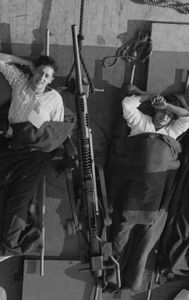Catalogue number 65045
Details of an Oerlikon gun
This bird's eye view of a 20mm Oerlikon gun on a U.S. Navy PT boat clearly shows the different parts of the gun - from the top of the photograph down, air-cooled barrel (note the cooling fins showing just out of the casing), barrel spring in its vented casing, barrel spring (to cock the gun, these strong springs had to be manually pulled back to the firing position), magazine support shoulder, magazine catch lever (coming up from the gun and bending to the right), trigger housing with the trigger stub to the left and just after the mounting fixture and finally, the hand grip. This gun is not fitted with the gunner's body strap and shoulder rests.
Verso: "Transfer of wounded sailors aboard a PT boat to be carried to a hospital ship off Southern coast of France. 16 Aug 1944"
Credit: Official U.S. Navy photograph
11cm x 8cm Gelatin silver print
|
 |